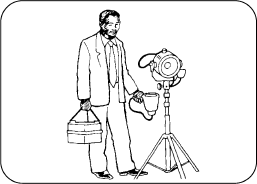Cameracrew Who’s Who
With the removal of the once-strict demarcation lines between crafts hastening the flexibility of working arrangements, it would be foolish to be dogmatic about the make-up of TV news camera crews, and it is no surprise to find two-person teams, single operators and video-journalists all jostling for position at the same news events. So in examining the main technical elements of news-gathering it is essential to be aware that some or all functions may be merged –with some practitioners also extending their range of skills to include picture editing, script writing or both.
Camera operators
Where two-person camera news teams remain in fashion, whoever operates the camera (US: photographer/videographer) is regarded as the senior member. Responsibility includes placing the camera in position, composing the picture and shooting the scene. Experienced camera-people are also respected for editorial nous gleaned over many assignments. Although as the reporter you are nominally in charge, if you are wise you will always listen to advice when it is offered.
Sound recordists
The recordist, where there is one, is chiefly responsible for ensuring speech levels are balanced and the right microphone is chosen for each assignment. Over the years the recordist’s technical expertise has been extended to include first-line maintenance of the equipment. As a help towards promotion the recordist has traditionally been given opportunities to use the camera under supervision. The value of the recordist as chauffeur, ‘fixer’ and main trouble-shooter may also be seen on difficult or dangerous assignments.
Engineers
In some organisations sound recordists as a separate breed have been superseded by versatile engineers whose multiplicity of duties includes general assistance to the camera operators but whose priority may be to ensure that the raw material, once gathered, is transmitted to base by the fastest possible route. This is usually by the microwave links or satellite systems which have become commonplace in news-gathering, especially abroad.
Electricians
Lighting assistants–electricians or ‘sparks’–tend to operate independently of the rest of the team. Their equipment probably consists of a portable rig of hand-held and free-standing lights powerful enough to provide the supplementary illumination by which film or videotape can be shot at indoor or poorly lit locations. News-camera teams are equipped with their own basic set of lights, good enough for most routine events, in addition to the light fitment available for attaching to the camera itself. As each new generation of lenses becomes more versatile and light-sensitive than the last, the number of occasions when separate lighting for news coverage is needed is fast being reduced.
The camera team
Advances in technology and the decline in strict demarcation between crafts has brought a flexible approach to news-gathering. The functions illustrated may be merged or extended.
Camera
Operator composes picture, records scene. In news, increasingly likely to work solo with one-piece camcorder equipped with built-in microphone and light.

Recordist/engineer
Responsible for microphone choice, first-line equipment maintenance, and seeing raw material from the camera is transmitted by the fastest possible route. Camera-operator’s ‘eyes and ears’ on dangerous assignments.

Electrician
A disappearing breed for routine news-gathering as camera teams may be equipped with their own set of portable lights.

